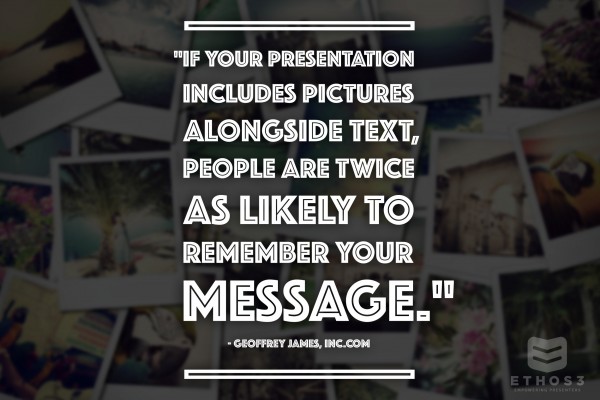A memorable presentation requires more than a brilliant idea. For a presentation to impact and stick with an audience over time, you must skillfully structure the content, strategically design the slides, and use public speaking techniques effectively.
Here are 12 tips for creating memorable presentations:
1. Structure Your Content: According to research, structured presentations are 40% easier to retain than freeform presentations. Consider building your presentation structure by answering the questions: 1) What? 2) So what? 3) Now what?

2. Use The Rule of Three. Most people can remember an average of three ideas from a presentation. Some people can easily remember more than that, but why push it to the limit? Make it easy for your audience to enjoy your presentation.
If you struggle to reduce your message to three key points, try grouping similar ideas together until you have no more than three categories that summarize your most important ideas. In all honesty though, you should be able to avoid this memory trick and refine your message to three crystal clear takeaways. Challenge yourself to focus and simplify your message.
3. Give your audience a break. The average adult starts to get antsy and lose interest after ten minutes of a presentation. Break up your more serious material by inserting lighter material every ten minutes. At a ten-minute mark, consider inserting a funny video that relates to your topic, or telling a relevant, but entertaining joke to lighten the mood. Give your audience some time to recover their mental energy every ten minutes, or risk losing their interest altogether.
4. Use Visuals. According to the Picture Superiority Effect, humans can more easily recall information when it is presented with graphics or images than with text. So, for example, instead of using the word CHAMPIONS on a slide, show a picture of your team accepting a big, shiny trophy. As you easily imagine, the image of your team’s smiling faces and celebratory body language will resonate with audience members much more than a few letters on a slide.

5. Be picky. Use visuals does not mean that you can use any visual. For visuals to be effective, they must be relevant to the content. Take the extra time to find or create visuals that clearly support the topic of your presentation. We have all seen presentations with random clip art carelessly strewn across slides, so it should be no surprise that research suggests irrelevant pictures accompanying text and sound effects decrease learning.
When trying to steer clear of distracting visuals, be cautious when downloading images from stock photography sites. While most stock sites are valuable resources, almost all of them are also minefields filled with cheesy images of ridiculously happy models, and people in obviously staged scenarios. While it is okay to be artistic in your image selection, don’t try to force an image that doesn’t clearly relate to the topic, and avoid over-the-top photos at all cost.
6. Write meaningful headlines. Don’t make your audience unravel a riddle to understand the meaning of your headline. Headlines that are comprised of a single word, or short phrase are often too cryptic to be memorable. Full sentences are the best way to distill a complex slide, without oversimplifying the message. According to a 2011 study by Johns Hopkins University, a full-sentence headline (written as an assertion) compared to a word or phrase increases retention of slide content, especially with a clear supportive graphic.
7. Don’t read from your slides. Instead of using the text on your slides as a script, use text only to add another layer of meaning to your oral and visual content. By doing this, you will help your audience develop a deeper relationship with your content, instead of burning them out with redundancies. According to research, information presented in one modality should complement, rather than simply repeat or conflict with, information presented in the other modality. Reportedly, interpreting redundant information requires parallel processing capacity that individuals do not have.
8. Minimize text on your slides. Don’t include your entire life story, every line of code, or every bullet point of your business plan in your presentation. It does not matter who is in the audience, or what topic you are covering, your presentation needs minimal text. While reading, our minds typically wander 20 to 40% of the time, according Belle Beth Cooper of Buffer. If you want an attentive audience, don’t ask them to read slides with superfluous statements.

If you don’t know how to breakup the long relationship between text and your presentation slides, try the 10/20/30 presentation technique introduced by Guy Kawasaki. 10/20/30 stands for: 10 slides, 20 minutes, 30-point font. Not only do you have only 10 slides but also your font is going to be quite large as well, making it difficult to overload slides with text. Get ready to watch your word count get smaller, and smaller, and smaller.
9. Tell a story. Think through your experiences, ask friends for relevant tales, or pick up some books; basically, do whatever it takes to find a story that will enhance your message, and then mix it into your presentation – either at the beginning, the end, or during a lull in your content. Why? In a nutshell, stories are experiential; we feel them, which is one reason why stories leave a lasting impression on listeners. In the words of John Kotter, an organizational change expert, Neurologists say that our brains are programmed much more for stories than for abstract ideas. Tales with a little drama are remembered far longer than any slide crammed with analytics.
10. Be creative with data. Don’t use standard bar graphs and pie charts in your presentations. We have all seen too many of those cliché data visualization styles. It appears that novel and unexpected visualizations can be better remembered than the visualizations with limited variability that we are exposed to since elementary school, according to the study What Makes a Visualization Memorable?.
11. Play music. This tip will not work for every presenter. Heck, it probably won’t work for most presenters however you should try it if you can make it work for you. Insert a song, or a segment of a song, into an appropriate spot of your presentation. Consider playing music while you walk to the stage. Then reference the song in a story during the intro of your presentation. Why all the hassle? Music embedded throughout a PowerPoint® presentation can sustain attention, while slipping the content into long-term memory, according to Ronald A. Berk’s study Research on PowerPoint: From Basic Features to Multimedia.
If you really want to stack the deck in your favor, get your audience revved up with a song featuring a strong melodic hook. Scientists recently announced that Wannabe by The Spice Girls is the catchiest song in the world. “Although this is just a casual observation on my part, very strong melodic hooks seem to be the most memorable for people,” lead researcher Ashley Burgoyne, of the University of Amsterdam, told the BBC, according to Melissa Dahl of NYmag.com.
12. Speak in short bursts. Your presentation should be comprised of small moments that are woven together to create a larger experience. In the article The Psychology of Language: Which Words Matter the Most When We Talk, Leo Widrich suggests speaking in short bursts to be more memorable. To support his suggestion, Widrich quoted Andrew Newberg’s book Words Can Change Your Brain: 12 Conversation Strategies to Build Trust, Resolve Conflict, and Increase Intimacy: Speak briefly, meaning that you speak one or two sentences, maybe 30 seconds worth or so, because that’s really what the human brain can take in.
To accomplish this challenging task, try breaking bigger concepts into smaller nuggets of information that can be packaged as individual moments for the audience to process. You can separate small chunks of information with a moment of silence. The silence can last for one breath, or several seconds. Select the pause length that works best with the pacing of your presentation. Sometimes a long pause is exactly what you need to add emphasis; other times, you want to keep your momentum so an almost imperceptible pause is the best option. Learn how to master the pause by watching some public speaking pros. Check out 5 Examples of the Presentation Pause to see examples of effective moments of silence during a speech.
Remember, your presentation is important. Be memorable!
Let us help you create an unforgettable presentation. Contact us today.
For more presentation inspiration, check out:
Cognitive Load Theory and Presentations [Podcast]
